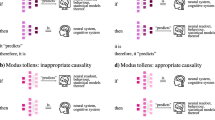Abstract
From the very inception of the concept of the neuron over a period of almost one hundred years (cf. Breidbach, 1993; Dierig, 1993; Finger, 1994), networks of neurons have been used to capture aspects of higher cognitive functions. Sigmund Freud (1895/1950) and Sigmund Exner (1894) conceived of the flow of energy through networks of neurons in order to explain psychology and psychopathology (see Figs. 1 and 2). Five decades later, McCullough and Pitts (1943/1989) were the first to posit the neuron as an information processing device, and again, suggested psychopathological applications (cf. Spitzer, 1997a) In the 1980s, neural network research gradually invaded almost every field of psychology (cf. Rumelhart & McClelland, 1986), and since the appearance of the landmark paper by Ralph Hoffman in 1987, an increasing number of network models of psychopathology have been proposed. In this paper, applications of neural networks for the understanding of psychology and psychopathology will be discussed. It is argued that the work by psychologists and psychiatrists is not merely a late “add on” to neural network research but rather an integral part of their lines of inquiry. Several examples will be discussed which should demonstrate that neurocomputational models represent the dearly needed bridge between the mind and brain aspect of human nature.
Access this chapter
Tax calculation will be finalised at checkout
Purchases are for personal use only
Preview
Unable to display preview. Download preview PDF.
Similar content being viewed by others
References
Breidbach, O. (1993): Nervenzellen oder Nervennetze? Zur Entstehung des Neuronenkonzepts, in: E. Florey and O. Breidbach, (eds.): Das Gehirn — Organ der Seele? (Akademie-Verlag, Berlin), pp. 81–126
Chomsky, N. (1978): Rules and Representations (Columbia University Press, New York)
Crick, F. (1988): What mad pursuit (Basic books, New York)
Crick, F. (1989): The recent excitement about neural networks. Nature 337, 129–132
Dierig, S. (1993): Rudolf Virchow und das Nervensystem. Zur Begründung der zellulären Neurobiologie, in: E. Florey and O. Breidbach, (eds.): Das Gehirn. — Organ der Seele? (Akademie-Verlag, Berlin), pp. 55–80
Elman, J.L. (1990): Finding structure in time, Cognitive Science 14, 179–211
Elman, J.L. (1991): Incremental learning, or The importance of starting small, in: Proceedings of the Thirteenth Annual Conference of the Cognitive Science Society, p. 443–448 (Erlbaum, Hillsdale, N.J.)
Elman, J.L. (1994): Implicit learning in neural networks: The importance of starting small, in: C. Umilty and M. Moscovitch (Eds.) Attention and Performance VI Conscious and nonconscious information processing (MIT Press, Cambridge, MA) p. 861–888
Exner S(1894): Entwurf zu einer physiologischen Erklärung der psychischen Erscheinungen, Deuticke, Leipzig, Wien
Finger, S. (1994): Origins of neuroscience. A history of explorations into brain function (Oxford University Press, Oxford)
Freud, S. (1978): Project for a scientific psychology (1895) The Standard Edition of the Complete Psychological Works of Sigmund Freud, vol. 1 (Hogarth Press, London) pp. 283–397
Hasselmo, M.E. (1994): Runaway synaptic modification in models of cortex: Implications for Alzheimer’s disease. Neural Networks 7(1), 13–40
Hobson, J.A. and McCarley, R.W. (1977): The brain as a dream state generator, American Journal of Psychiatry 134: 1335–1348
Hoeffner, J. (1992): Are rules a thing of the past? The acquisition of verbal morphology by an attractor network, Proceedings of the Fourteenth Annual Conference of the Cognitive Science Society (Erlbaum, Hillsdale, New Jersey) p. 861–866
Hoffman, R.E. (1987): Computer simulations of neural information processing and the schizophrenia-mania dichotomy, Archives of General Psychiatry 44, 178–185
Hoffman, R.E., Rapaport J., Ameli, R., McGlashan, T.H., Harcherik, D. and Servan-Schreiber, D. (1995): The pathophysiology of hallucinated ‘voices’ and associated speech perception impairments in psychotic patients, Journal of Cognitive Neuroscience 7 479–496
Marcus, G.F. (1995): The acquisition of the English past tense in children and multi-layered connectionist networks, Cognition 56, 271–279
McCullouch, W.S. and Pitts, W. (1943/1988): A logical calculus of the ideas immanent in nervous activity, in: J. A. Anderson and E. Rosenfeld (eds.): Neurocomputing. Foundations of Research (MIT Press, Cambridge, MA) pp. 18–27
Mozer, M.C. (1993): Neural net architectures for temporal sequence processing, in: A. Weigand and N. Gershenfeld (Eds.) Predicting the future and understanding the past (Addison-Wesley, Reading, MA)
Neumann, J.V. (1958): The computer and the brain (Yale University Press, New Haven)
Pinker, S. (1994): The language instinct. How the mind creates language (William Morrow and Company, New York)
Pinker S. and Prince A. (1988): On language and connectionism: An analysis of a parallel distributed processing model of language acquisition, Cognition 28 73- 193
Plunkett, K. (1995): Connectionist approaches to language acquisition, in: Fletcher, P. and MacWhinney, B. (Eds.): Handbook of Child Language (Blackwell, Oxford) pp. 36–72
Plunkett, K. and Marchman, V. (1991): U-shaped learning and frequency effects in a multi-layered perceptron: Implications for child language acquisition, Cognition 38, 1–60
Reggia, J.A., Ruppin, E. and Berndt, R.S. (1997): Neural Modeling of Brain and Cognitive Disorders (World Scientific, Singapore)
Rumelhart, D.E. (1989): The architecture of mind: A connectionist approach, in: Posner MI (ed.): Foundations of cognitive science (MIT Press, Cambridge, MA) pp. 133–159
Rumelhart, D. and McClelland, J.L. (1986): On Learning the past tense of English verbs, in: D. E. Rumelhart and J. L. McClelland, PDP Research Group: Parallel distributed processing: Explorations in the microstructure of cognition, Vol. II (MIT Press, Cambridge) pp. 216–271
Spitzer, M. (1997): The History of Neural Network Research in Psychopathology, in: D. Stein (ed.) Neural Networks and Psychopathology (Cambridge University Press, Cambridge, UK) (in press)
Author information
Authors and Affiliations
Editor information
Editors and Affiliations
Rights and permissions
Copyright information
© 1998 Springer-Verlag Berlin Heidelberg
About this chapter
Cite this chapter
Spitzer, M. (1998). Neural Network Models in Psychology and Psychopathology. In: Ratsch, U., Richter, M.M., Stamatescu, IO. (eds) Intelligence and Artificial Intelligence. Springer, Berlin, Heidelberg. https://doi.org/10.1007/978-3-662-03667-9_11
Download citation
DOI: https://doi.org/10.1007/978-3-662-03667-9_11
Publisher Name: Springer, Berlin, Heidelberg
Print ISBN: 978-3-642-08358-7
Online ISBN: 978-3-662-03667-9
eBook Packages: Springer Book Archive




